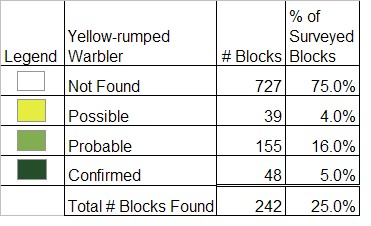Find a Bird - BBA1
Breeding Bird Atlas 1 Species Accounts
Yellow-rumped Warbler
Dendroica coronata
Egg Dates
May 20 to late July
Number of Broods
one or two

The hardy Yellow-rumped Warbler is the only member of its tribe that can be found in significant numbers somewhere in the state in any season. It is the most abundant warbler during both spring and fall migrations, when many individuals pass through Massachusetts en route to and from the extensive northern breeding grounds. Forbush gave the status of the species during the breeding season as “uncommon to rare and local...chiefly on the high lands of the western counties east to eastern Worcester County” and “casual in the eastern counties south to Plymouth County.” This is the same nesting distribution that was established for the species during the Atlas period. The change is that, within this range, the Yellow-rumped Warbler has apparently increased its numbers. It is now widely distributed throughout the western and northern portions of the state, and it may be common in favorable habitats. Yellow-rumped Warblers also appear to be established breeders, rather than merely casual, in northern Middlesex County and in Plymouth County.
Yellow-rumped Warblers will nest in several forest types, but the common factor is that some kind of evergreen needs to be present. Breeding territories may be located in coniferous woods of spruce, hemlock, or pine; in young conifers at the edge of more mature forest; or in mixed woods containing stands of conifers, especially mature White Pines.
The song of the Yellow-rumped Warbler is a variable, musical trill, sometimes broken into separate notes, often containing double elements and sometimes changing pitch near the end. The resident males sing from late April to early August. Both sexes give a seet note, a diagnostic check call, and a scolding tchip. Young birds have a characteristic food-begging call.
Spring migration extends from the second week of April to the end of May, with the biggest flights occurring in late April and early May. Territorial males court prospective mates in typical warbler fashion, chasing them or approaching closely with the plumage fluffed. Nest building and incubation are carried out primarily by the female. Nests are usually placed on a horizontal branch of an evergreen, although sometimes a hardwood tree will be selected. These cups of bark, twigs, and plant fibers may be located from 4 to 50 feet high, and they are unique among warbler nests. In addition to the usual lining of fine grasses and hair, they contain many feathers with the shafts woven into the nest structure and the tips forming a screen over the eggs.
Three Massachusetts nests were located as follows: one not far from the end of a long branch near the top of a tall White Pine in a pasture in Webster, one in Carver 25 feet up in a White Pine (EHF), and one 6 feet up on a branch next to the trunk of a small Red Cedar in Pelham. This last nest was a shallow cup of cedar twigs, bark, plant fibers, string, and pine needles lined with horsehair and many grouse feathers.
The four to five (rarely three or six) eggs are incubated for 12 to 13 days, and the young are fed in the nest by both parents for 12 to 14 days. In Massachusetts, as well as in other localities, some pairs raise two broods in a season. Nestlings have been reported in the Commonwealth from June 6 to August 2 (EHF), and the range is probably greater because a female was observed gathering nesting materials as late as July 24 (Nice 1936). The Pelham nest contained three newly hatched young on July 25, and these fledged on August 3. The fledglings are fed by the parents for several weeks as they gradually attain independence. Fledglings have been observed in the state from June 14 (a female and one very young fledgling) to August 21 (a male and two large fledglings). Pairs or single birds were feeding from one to three young (Nice 1926, Meservey). Once the second set of youngsters has left the nest, the family group may wander together or the parents may divide the family and separate.
By mid- to late August, both old and young birds have completed their molts. At this time, Yellow-rumped Warblers can be found in the mixed-species flocks of woodland birds as they begin to depart from the breeding grounds. In September, migrants appear, with large numbers passing through during October and well into November. No longer confined to forest, the Yellow-rumped Warbler may then be encountered in all types of more open habitats.
The winter range of the Yellow-rumped Warbler is extensive, reaching from Pennsylvania, New York, and coastal Maine south through the southern states, West Indies, and Mexico to Panama. During the winter in Massachusetts, the species is common locally along the coast and rare west to central Worcester County and the Connecticut River valley. The birds are able to withstand northern winters by switching from a primarily insectivorous diet to one of Bayberry and other small fruits.
Map Legend and Data Summary
Atlas 1 data collected from 1975-1979


Note: fairly common in coniferous and mixed forests of hill country; occasional in southeastern region
W. Roger Meservey



